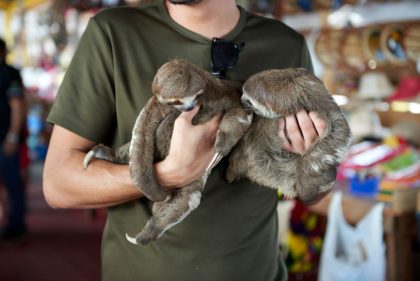
Courtesy
Selfies and and photographs with wild animals on social networks contribute to animal cruelty, according to a recent analysis by World Animal Protection in conjunction with the digital agency Grassriots.
Since July, both agencies have begun to work on understanding the scope and impact of wildlife selfies, which are an increasingly common manifestation of ecotourism.
Kangaroos, elephants, sloths, turtles, primates, tigers, lions, giraffes, koalas and dolphins are the most common species on social networks. The study included 21 countries and Costa Rica ranked seven in the list of countries where this activity is most practiced.
Roberto Vieto, wildlife manager for World Animal Protection, explained that since 2015 a campaign called “Wild, not entertainment” has been launched, aimed at stopping animal abuse in tourism or entertainment situations.
A study had already been carried out and it was estimated that more than 550,000 wild animals could be suffering from tourism or entertainment activities. With this new study, what we are revealing is that animal cruelty not only occurs in situations of captivity, but when people are encouraged to visit national parks or areas with some category of protection, or even places with forest or jungle cover, there is also a problem of animal cruelty,”
explained Vieto.
He added that the study was based on the amount of selfies and photographs with wild animals that are recorded in Latin America.
At least 250 places or tourist attractions were promoting direct contact with wildlife, which is alarming. At least 60% of the species used are listed in the International Convention on Trade in Wild Animals and Plants, which indicates that the animals are at risk and threatened,”
said Vieto.
Recently, the Costa Rican Government has approved a new guideline of the Wildlife Conservation Law, which regulates the use of images with wild animals in advertising campaigns, documentaries, reports, filming and others. It also prohibits the dissemination and emission of images where tourists have direct contact with wild animals -feeding, holding, caressing or swimming with them- with the aim of preventing people from turning them into pets.
The regulation also prohibits unqualified personnel from manipulating wild animals at tourist sites such as rescue centers or zoos. For World Animal Protection, this is an important measure that
would diminish the promotion of unethical tourism with wild animals, so common in other parts of Latin America … Legislation of this type is essential to protect Latin American fauna from animal abuse they may suffer in unethical tourist places with wildlife,”
said Vieto.
Days ago, 40 representatives from different organizations asked the Ministry of Environment and Energy (MINAE) to suspend the application of the new regulation of the Wildlife Conservation Act, according to a statement from the National Tourism Chamber. They want articles that affect wildlife management and tourism to be analyzed.